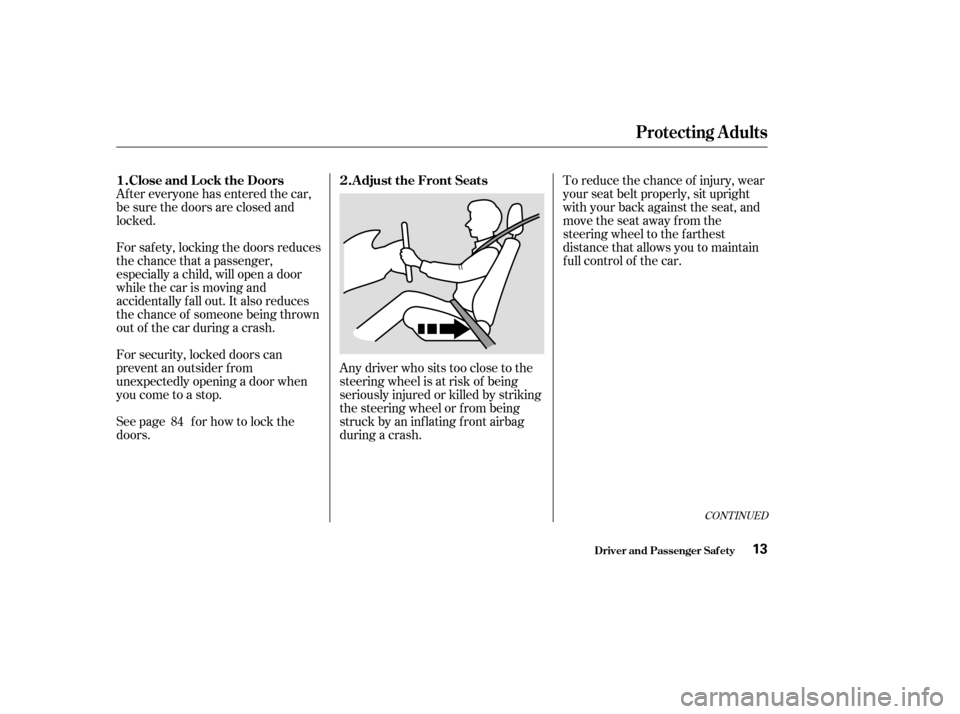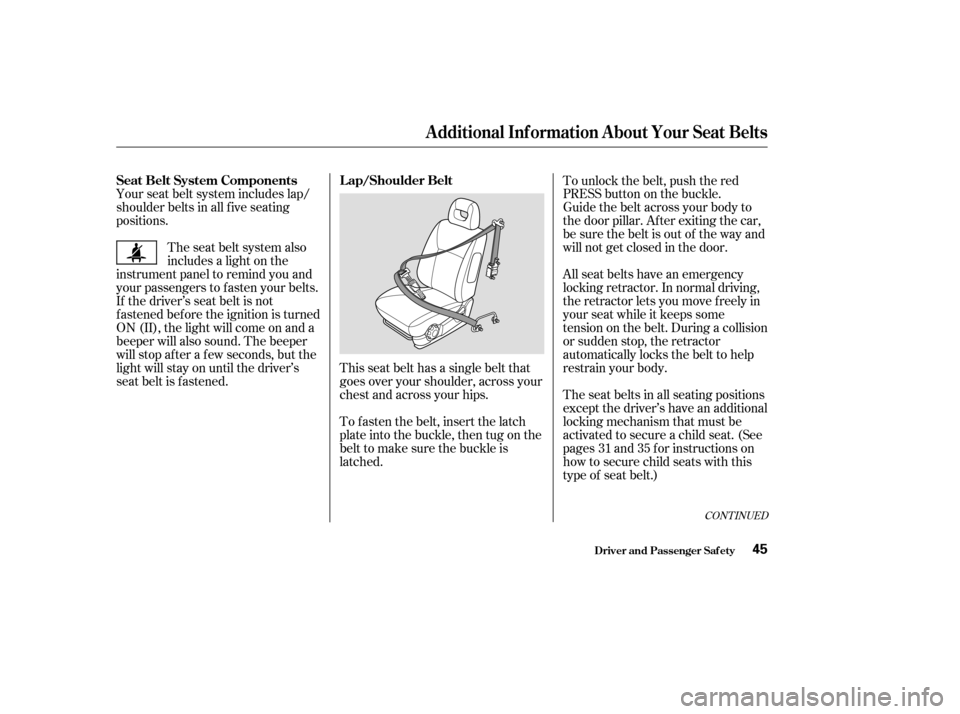Page 1 of 302
Your Car at a Glance
2
(P. 84)
(P. 96)
POWER
DOOR LOCK
SWITCH
POWER WINDOW
SWITCHES
HOOD RELEASE
HANDLE
(P. 158) (P. 110)
HEATING/COOLING CONTROLS
FUEL FILL DOOR RELEASE
(P. 157)
A/T model is shown.
TRUNK RELEASE
(P. 88)
(P. 174)
AUTOMATIC TRANSMISSION
MANUAL TRANSMISSION
(P. 172) (P.118,130)
AUDIO SYSTEM
DIGITAL CLOCK
(P.123,135)
GAUGES
INDICATOR LIGHTS AIRBAGS
(P. 10, 49)
(P. 69)
(P. 61)
�����—�����—�����y�
�������������y���
�(���%�������y���������y
Page 5 of 302
Your car is equipped with many
features that work together to
protect you and your passengers
during a crash.
Some saf ety f eatures do not require
anyactiononyourpart.These
include a strong steel f ramework
that forms a safety cage around the
passenger compartment; f ront and
rear crush zones that are designed to
crumple and absorb energy during a
crash; a collapsible steering column;
and seat belt tensioners that
automatically tighten the front seat
belts in the event of a crash.
CONT INUED
Driver and Passenger Saf ety
Your Car’s Saf ety Features
7
(7)(11)(9) (2)
(8)
(6)
(4)
(3)
(1)
(8)
(10)
(7)
(5)
(2)
(1) Safety Cage
(2) Crush Zone
(3) Seats and Seat-Backs
(4) Head Restraints
(5) Collapsible Steering Column
(6) Seat Belts
(7) Front Airbags
(8) Side Airbags (Optional)
(9) Seat Belt Tensioners
(10) Door Locks
(11) Seat Belt Buckle Tensioners
�����—�����—�����y�
�������������y���
�(���%�������y�����
���y
Page 9 of 302

Head restraints can help protect you
f rom whiplash and other injuries. For
maximum protection, the back of
your head should rest against the
center of the head restraint.Move the f ront
seats as far back as possible, and
keep adjustable seat-backs in an
upright position whenever the car is
moving. Keeping your doors locked reduces
thechanceof beingthrownoutof
the car during a crash. It also helps
prevent occupants f rom accidentally
opening a door and f alling out, and
outsiders f rom unexpectedly opening
your doors.
Your car’s seats are designed to keep
you in a comf ortable, upright
position so you can take f ull
advantage of the protection offered
by seat belts and the energy
absorbing materials in the seats.
How you adjust your seats and seat-
backs can also affect your safety. For
example, sitting too close to the
steering wheel or dashboard
increases the risk of you or your
passenger being injured by striking
theinsideof thecar,orbyan
inf lating airbag.
Reclining a seat-back too f ar reduces
the seat belt’s ef f ectiveness and
increases the chance that the seat’s
occupant will slide under the seat
belt in a crash and be seriously
injured. Head Restraints
Door L ocks
Seats and Seat-Backs
What you should do:
Driver and Passenger Saf ety
Your Car’s Saf ety Features
11
�����—�����—�����y�
���������
���y���
�(���%�������y�����
���y
Page 10 of 302

All adults, and children who have
outgrown child saf ety seats, are
wearing their seat belts and
wearingthemproperly(seepage).
Any inf ant or small child is
properly restrained in a child seat
inthebackseat(seepage ).
To make sure you and your
passengers get the maximum
protection f rom your car’s saf ety
f eatures, check the f ollowing each
time before you drive away:
Frontseatoccupantsaresitting
upright and as f ar back as possible
f rom the steering wheel and
dashboard (see page ). Seat-backs are upright (see page
).
Head restraints are properly
adjusted (see page ).
Both doors are closed and locked
(see page ).
All cargo is properly stored or
secured (see page ).
Remember, however, that no saf ety
system can prevent all injuries or
deaths that can occur in severe
crashes, even when seat belts are
properly worn and the airbags deploy.
The rest of this section gives more
detailed inf ormation about how you
can maximize your saf ety. The f ollowing pages provide
instructions on how to properly
protect the driver and other adult
occupants.
These instructions also apply to
children who have outgrown child
seats and are large enough to wear
lap/shoulder belts. (See page f or
important additional guidelines on
how to properly protect larger
children.)
16
21
13 14
15
13 37
165
Pre-Drive Saf ety Checklist
Introduction
Your Car’s Saf ety Features
Driver and Passenger Saf ety12
�����—�����—�����y�
�����������
�y���
�(���%�������y�����
���y
Page 11 of 302

CONT INUED
Af ter everyone has entered the car,
be sure the doors are closed and
locked.
For saf ety, locking the doors reduces
the chance that a passenger,
especially a child, will open a door
while the car is moving and
accidentally f all out. It also reduces
the chance of someone being thrown
out of the car during a crash.
For security, locked doors can
prevent an outsider f rom
unexpectedly opening a door when
you come to a stop.
See page f or how to lock the
doors.Any driver who sits too close to the
steering wheel is at risk of being
seriously injured or killed by striking
the steering wheel or f rom being
struck by an inflating front airbag
during a crash.To reduce the chance of injury, wear
your seat belt properly, sit upright
with your back against the seat, and
movetheseatawayfromthe
steering wheel to the f arthest
distance that allows you to maintain
f ull control of the car.
84
Protecting Adults
Driver and Passenger Saf ety
Close and L ock the Doors A djust the Front Seats
1. 2.
13
�����—�����—�����y�
�����������
�y���
�(���%�������y�����
���y
Page 23 of 302

Leaving children without
adult supervision is illegal in most
states and Canadian provinces,
and can be very hazardous. For
example, inf ants and small
childrenleftinavehicleonahot
day can die f rom heatstroke. And
children lef t alone with the key in
the ignition can accidentally set
the vehicle in motion, possibly
injuring themselves or others. Even very young
children learn how to unlock
vehicle doors, turn on the ignition,
and open the trunk, which can
lead to accidental injury or death.
Children who play in cars can
accidentally get trapped inside the
trunk and be seriously injured or
could die. Teach your children not
to play in or around cars. Know
how to operate the emergency
trunk opener and decide if your
children should be shown how to
use this f eature (See page ). 89
Protecting Children
Driver and Passenger Saf ety
Do not leave children alone in your
vehicle. K eep car keys and remot e
transmitters out of the reach of
children.
Lock both doors and the trunk when your car is not in use.
Additional Saf ety Precautions
25
�����—�����—�����y�
�������������y���
�(���%�������y���������y
Page 43 of 302

This seat belt has a single belt that
goes over your shoulder, across your
chest and across your hips.
Your seat belt system includes lap/
shoulder belts in all f ive seating
positions.
The seat belt system also
includes a light on the
instrument panel to remind you and
your passengers to f asten your belts.
If the driver’s seat belt is not
fastened before the ignition is turned
ON (II), the light will come on and a
beeper will also sound. The beeper
will stop af ter a f ew seconds, but the
light will stay on until the driver’s
seat belt is f astened. The seat belts in all seating positions
except the driver’s have an additional
locking mechanism that must be
activated to secure a child seat. (See
pages and f or instructions on
how to secure child seats with this
type of seat belt.)
All seat belts have an emergency
locking retractor. In normal driving,
the retractor lets you move f reely in
your seat while it keeps some
tension on the belt. During a collision
or sudden stop, the retractor
automatically locks the belt to help
restrain your body.
Guide the belt across your body to
the door pillar. Af ter exiting the car,
be sure the belt is out of the way and
will not get closed in the door.
To unlock the belt, push the red
PRESSbuttononthebuckle.
To fasten the belt, insert the latch
plate into the buckle, then tug on the
belt to make sure the buckle is
latched. 31 35
CONT INUED
Seat Belt System Components L ap/Shoulder Belt
Additional Inf ormation About Your Seat Belts
Driver and Passenger Saf ety45
�����—�����—�����y�
�������������y���
�(���%�������y���������y
Page 57 of 302
Control L ocations
Inst rument s and Cont rols60
MOONROOF MIRRORCONTROLSHEATING/COOLING CONTROLS
HOOD RELEASE
HANDLE CRUISE CONTROL
BUTTONS
FUEL FILL DOOR RELEASE
A/T model is shown. POWER WINDOW
SWITCHES
POWER DOOR LOCK
SWITCH
(P. 98)
(P. 99)(P. 110)
(P. 152)
(P. 158)
(P. 157)
(P. 96)
CRUISE CONTROL
MASTER SWITCH
(P. 151)
(P. 84)
TRUNK RELEASE(P. 88) DIGITAL CLOCK
(P. 118, 130)
AUDIO SYSTEM
(P.123,135)
�����—�����—�����y�
����
�
������y���
�(���%�������y���������y